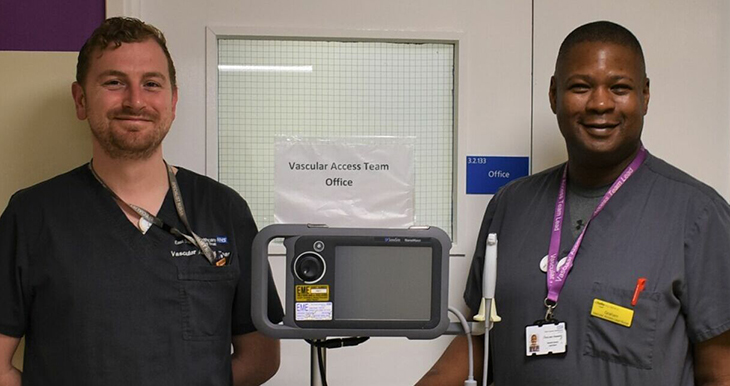
Patients tend to be referred to the vascular access team when they are classed as having difficult intravenous access (DIVA), which means their veins can be difficult to find or access. This can cause problems with anything from getting bloods to putting lines in for medication, chemotherapy, long term IV feeding or blood transfusions.
Patients are referred to the team of 10 and the patient’s treatment plan is discussed as well as what the best type of line for them might be. The patient can be referred as an inpatient or an outpatient. Once the line is in, treatment can be provided both in hospital or in the community. Last year the team placed over 700 lines in acute patients alone.
Not every trust is fortunate enough to have a specialist vascular access team. Formed in 2007 the main aim of the team is to lower the contamination rates of patient lines – now only at 3% across the trust, and below the national average. The team provide training and education to patients and colleagues on post insertion care, and crucially, improve patient experience from the discomfort of multiple attempts at accessing a vein.
We spoke to Graham Howard, Lead Vascular Access Clinical Nurse Specialist, about his team, what they do and how they are improving patient care.
“The team take a lot of care and pride in the job we do here,” says Graham. “We are a small team but we work across the trust in our acute hospitals and offer support and advice to our colleagues in the community.”
The team have made it much easier to identify DIVA patients, by including new information on E-Searcher (the trust’s booking system) and attaching alerts to patient records so they can be referred straight to the vascular team.
“We deliver training across the trust, so that colleagues are up to date with all developments in vascular access including the different vascular devices,” continues Graham. “We have worked with the learning development team to analyse the training needs of staff and help bring vascular care to the heart of health care. We work hard to ensure patients get the right care, at the right time, in the right place.
The team work across the whole patient pathway, from the point of referral up until they are discharged.
“A normal day will involve going through the referrals from triage, then the DIVA list,” explains Graham. “We also visit patients before they return home, either to check their line is ok or to take it out before they are discharged. Recently we have been working with the new virtual wards team to assist them with innovations such as the elastomeric and volumetric IV pumps to enable a new cohort of patients to be treated at home instead of staying in hospital. Our skills reduce the pressure on other teams and allow the patient as much comfort as possible. In the future we hope to secure a dedicated vascular access unit to improve inpatient services and what we can offer to community patients as virtual wards expand.
“I am really proud to work in this team,” Graham concludes. “We are a very diverse group and all of us bring a different skillset to the table. We complement each other and are able to look at patient’s priorities differently, so that we can advise over the entire journey of their treatment.”
